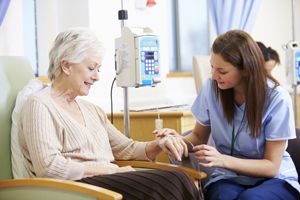Better Multimodal Interventions Are Needed To Support Sexual Health in Female Cancer Survivors
Effective interventions exist for cancer-related sexual dysfunction, but higher-quality research is still needed to optimize management.
Better Multimodal Interventions Are Needed To Support Sexual Health in Female Cancer Survivors

Although effective interventions exist to mitigate sexual health challenges for female cancer survivors, better high-quality research is needed to translate these interventions into clinical practice, according to findings from a narrative review that was published in the Journal of Clinical Oncology.1
“There is evidence that sexual health challenges exist for a wide variety of female cancer survivors,” Noël Arring, PhD, DNP, RN, of University of Tennessee College of Nursing, and co-authors wrote in the review. “Effective interventions exist for many of these challenges, although more high-quality intervention research and multimodal intervention research are needed.”
The reviewers identified 4 key areas of concern for female cancer survivors: low sexual desire, vulvovaginal symptoms, negative body image, and sexual partner relationships. Strong evidence supports the use of behavioral interventions, including psychosexual counseling, and psychoeducation, to address desire, body image, and sexual partner relationships. Couple-based psychosexual interventions have also been found to be effective for female survivors with partners.
Unfortunately, although pharmacologic treatments may have some usefulness in treating vulvovaginal atrophy, they have not shown efficacy for other sexual-health–related concerns.
Low Desire
For many female cancer survivors, low sexual desire is a chief concern.2 The review demonstrated that the causes driving low sexual desire are often multifold and may include biologic forces—such as poor sleep, and physiological symptoms—such as depression and anxiety—as well as interpersonal issues.3 Poor body image, general bodily pain, and adjuvant endocrine therapy can all also lower an individual’s desire to engage in sexual activity.4
Some investigators had anticipated that bupropion, which is a dopamine-norepinephrine reuptake inhibitor, might be effective in improving low sexual desire in female cancer survivors, but the agent failed to best placebo in the clinical trial setting. Yet, in that same study, over 90% of participants shared that they also were experiencing vulvovaginal symptoms. Because vulvovaginal symptoms can cause pain during sex, effectively hampering desire, bupropion’s ability to improve desire may have been limited.5
The FDA has approved 2 pharmacologic agents, flibanserin (Addyi) and bremelanotide (Vyleesi), for hyporeactive sexual desire disorder in premenopausal women. However, neither agent has been specifically assessed in a population of female cancer survivors. An ongoing open-label observational study is evaluating flibanserin in women with a history of breast cancer and results are expected in late 2023.6
Vulvovaginal Issues
Patients who undergo chemotherapy, radiation therapy, or estrogen deprivation may experience vaginal shortening and tissue atrophy; the thinning and loss of elasticity, fibrosis, and telangiectasias can all lead to lubrication issues and consequent pain during intercourse.7
First-line nonhormonal treatments include lubricants, polycarbophil-based vaginal moisturizers, and hyaluronic acid-based moisturizers. According to 1 study, optimal use includes nightly application for up to 12 weeks, targeting the vulvar vestibule and labia, and reapplying after any sexual activity. According to Arring and her co-authors, well-designed, comparative effectiveness trials with a diverse population of survivors are needed to see if early intervention with these treatments can prevent vulvovaginal issues.8
The use of 4% lidocaine was shown to have some effectiveness in reducing pain and boosting arousal compared with received physiologic saline in patients who reported penetrative dyspareunia. Both groups reported improved sexual distress scores by the 4th week mark. Arring noted that lidocaine could help manage dyspareunia but that it is not likely to directly improve tissue health, and therefore should be accompanied by a nonhormonal vaginal moisturizing agent. Lastly, although many have been optimistic about the application of laser treatments, the studies that have assessed their use in female cancer survivors have been criticized for having a high risk of bias, and one study that, according to Arring, was a well-powered, well-designed sham controlled randomized trial, did not show that laser treatment improved vulvovaginal symptoms or quality-of-life scores.9,10
There have been studies which have evaluated hormonal treatments, including estradiol, estriol, testosterone, and dehydroepiandrosterone, to improve vulvovaginal atrophy. Most of this research has included lowest-dose or lower potency estrogen. Studies that include a concentrated measure of the sex steroid tend to show a slight increase of hormones—followed by a decrease—and studies that include a lower dose tend to show that patient levels remain in the postmenopausal range. No studies have definitely demonstrated that a certain amount of sex steroid hormones offers patients a clear benefit with low risks. Therefore, most guidelines suggest trying a low-dose hormonal agent only if other options have not improved patient symptoms.11
The authors also noted that sexual rehabilitation interventions—which can include dilators, pelvic floor muscle training, and yoga—show promise in this setting but have not been sufficiently assessed.12
Body Image
The authors noted that patients with a negative body image are likely to also experience anxiety, depression, and sexual concerns. This is especially true for younger patients who premenopausal and have bowel or bladder incontinence.13
Psychosexual counseling has been shown to help these survivors improve their body perception. Six studies showed that patients benefited from cognitive-based therapy, couples-based sexual education and counseling, self-healing training, and group therapy with guided imagery. Some studies also demonstrated that internet-based CBT could help patients improve their body image and subsequent sexual desire. However, it is important to note that a lack of insurance, and difficulty accessing knowledgeable professionals, represent a barrier to this care.
Other interventions that investigators are optimistic about include group physical activity and expressive writing.
Relationship Context
The authors concluded by noting that sexual partners are a critical context for sexual health conversation. For instance, one study demonstrated that among breast cancer survivors who had completed treatment and met the criteria for sexual dysfunction, two-thirds of their male partners experience erectile dysfunction. Similarly, it has been found that when survivors perceive that their partners are experiencing lower sexual satisfaction, the survivor’s own arousal and satisfaction is also lower. Partners may experience conflicting emotions about their experiences. For instance, they may feel guilty about initiating sex if they know their partner has been experiencing painful intercourse.14
Because of these reasons, it is advised that partners be included in the management of sexual dysfunction. Couple-based interventions are often affective in addressing the concerns of female survivors.
“Important knowledge gaps exist in better understanding the needs of populations from diverse backgrounds including unpartnered women,” the study authors concluded. “Cancer care delivery research is urgently needed to translate existing effective interventions into practice, including strategies to improve patient-provider communication around this topic.”
References
- Arring N, Barton DL, Reese JB. Clinical practice strategies to address sexual health in female cancer survivors. Published online August 3, 2023. J Clin Oncol. doi:10.1200/JCO.23.00523
- Holloway V, Wylie K. Sex drive and sexual desire. Curr Opin Psychiatry. 2015 Nov;28(6):424-9. doi:10.1097/YCO.0000000000000199
- Kingsberg SA, Althof S, Simon JA, et al. Female sexual dysfunction-medical and psychological treatments, committee 14. J Sex Med. 2017;14(12):1463-1491. doi:10.1016/j.jsxm.2017.05.018
- Luo F, Link M, Grabenhorst C, Lynn B. Low sexual desire in breast cancer survivors and patients: a review. Sex Med Rev. 2022;10(3):367-375. doi:10.1016/j.sxmr.2022.02.001
- Barton DL, Pugh SL, Ganz PA, et al. Randomized controlled phase II evaluation of two dose levels of bupropion versus placebo for sexual desire in female cancer survivors: NRG-CC004. J Clin Oncol. 2022;40(4):324-334. doi:10.1200/JCO.21.01473
- Goldfarb S, Carter J: A study of flibanserin in breast cancer survivors on tamoxifen or aromatase inhibitors. ClinicalTrials.gov identifier: NCT03707340. Last update May 25, 2023. Accessed August 25, 2023. https://clinicaltrials.gov/ct2/show/NCT03707340?
- Smith T, Kingsberg SA, Faubion S. Sexual dysfunction in female cancer survivors: addressing the problems and the remedies. Maturitas. 2022;165:52-57. doi:10.1016/j.maturitas.2022.07.010
- Mendoza N, Carrión R, Mendoza-Huertas L, Jurado AR. Efficacy and safety of treatments to improve dyspareunia in breast cancer survivors: a systematic review. Breast Care (Basel). 2020;15(6):599-607. doi:10.1159/000506148
- Goetsch MF, Lim JY, Caughey AB. A practical solution for dyspareunia in breast cancer survivors: a randomized controlled trial. J Clin Oncol. 2015;33(30):3394-3400. doi:10.1200/JCO.2014.60.7366
- Li FG, Maheux-Lacroix S, Deans R, et al. Effect of fractional carbon dioxide laser vs sham treatment on symptom severity in women with postmenopausal vaginal symptoms: a randomized clinical trial. JAMA. 2021;326(14):1381-1389. doi:10.1001/jama.2021.14892
- Carter J, Lacchetti C, Andersen BL, et al. Interventions to address sexual problems in people with cancer: american society of clinical oncology clinical practice guideline adaptation of cancer care ontario guideline. J Clin Oncol. 2018;36(5):492-511. doi:10.1200/JCO.2017.75.8995
- Brennen R, Lin KY, Denehy L, Frawley HC. The effect of pelvic floor muscle interventions on pelvic floor dysfunction after gynecological cancer treatment: a systematic review. Phys Ther. 2020;100(8):1357-1371. doi:10.1093/ptj/pzaa081
- Morales-Sánchez L, Luque-Ribelles V, Gil-Olarte P, Ruiz-González P, Guil R. Enhancing self-esteem and body image of breast cancer women through interventions: A Systematic Review. Int J Environ Res Public Health. 2021;18(4):1640. doi:10.3390/ijerph18041640
- Reese JB, Zimmaro LA, McIlhenny S, et al. Coping with changes to sex and intimacy after a diagnosis of metastatic breast cancer: results from a qualitative investigation with patients and partners. Front Psychol. 2022;13:864893. doi:10.3389/fpsyg.2022.864893




